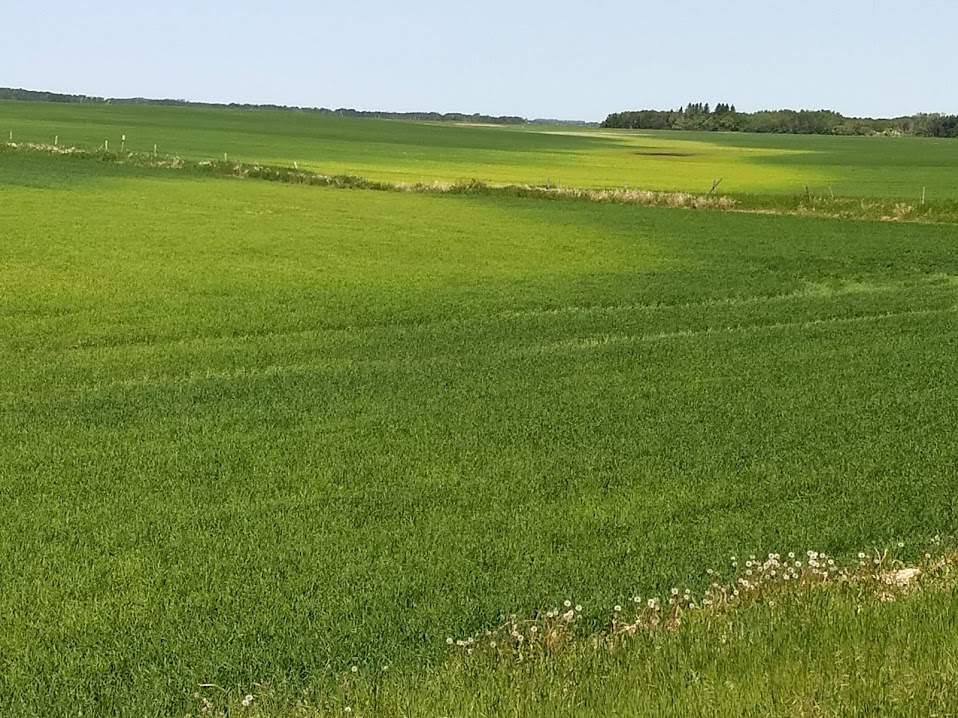After a number of years of generally wet conditions across the prairies, last year provided a break with wide-spread drought conditions. This spring continued with dry conditions across much of Western Canada but recently, we have moved into a more normal weather pattern with most of the rain falling as a result of thunderstorms. These are typified by a localized downpour of 10 cm (3.5”) or more in one swath with little or no rain only miles away.
With the heavy downpours, I have received a couple of questions about the yellow “patches” that appear after these rains.
What is the cause of this phenomenon? Generally, the yellowing is a result of O2 deficiency. Just like animals, plants need oxygen to function. Research in flooded soils has shown that the oxygen concentration approaches zero after 24 hours. Without oxygen, the plant cannot perform critical life-sustaining functions such as respiration, water uptake, root growth, etc. Water-logging also leads to accumulations of compounds like CO2, which are toxic to plants in high concentrations.
Affects of flooding on crops
Unless you are growing rice, your crop is intolerant of flooding. Flooding depletes soils of oxygen and increases disease infections and nitrogen losses.
Weather conditions following flooding are important to overall plant survival. Cool, wet conditions favour disease development. Many diseases, acting as opportunists, attack weakened plant tissue including leaves and roots. Very hot, windy conditions may dry soils too quickly, causing stress and restricted plant growth. Early in the season, it may also cause crusting of soil and emergence issues.
Crop condition may not be apparent for several days after flooding, requiring patience in replant decisions. Check plant meristems to assess damage and recovery potential.
Replanting should be a strictly economic decision that considers the yield potential of the reduced stand vs. that of a later-planted crop minus replant costs. However, experience tells me that by the time you access the drowned-out area of the field with equipment, it will be too late to replant.
Some crop species survive flooding better than others. Beans and peas may not survive one day of flooding while cereals can usually withstand 3-4 days. Soybeans generally survive flooding better than other crops but diseases increase, symbiotic nitrogen fixation diminishes, and yield is often reduced.
When planted cropland is flooded by excessive spring rains, some degree of damage to the crop is usually inevitable. The extent of the damage depends on the specific crop, its growth stage, the duration of flooding, and temperatures during flooding. Damage occurs because flooded soils quickly deplete oxygen, and most crops require oxygen for normal metabolism, growth, and development. Flooding frequently results in higher levels of plant diseases that reduce stands and yields. Finally, flooding usually causes soil nitrogen (N) losses, which can severely limit yields if N is not replaced. These losses occur from denitrification losses, runoff, and leaching. Denitrification losses can occur at the rate of greater than 4-5%/acre/day. This equates to 25% losses in five days and 50% losses over 10 days.
Under flooded conditions, stomata in affected plants close and may remain closed for long periods, resulting in reduced respiration, transpiration and photosynthesis. Plants may be slow to recover when water recedes. Long-term impacts on the crop are often related to disease infection and delayed root development that limits access to available subsoil moisture later in the season.
Is there a solution?
Finally – what remedial actions can be taken to help the crop recover? There are no silver bullets. The application of a fungicide may help reduce diseases moving into a weakened crop. However, the idea of a health benefit exhibited by some strobilation fungicides miraculously turning a damaged crop green are over promoted. An application pre-flooding may help but one post probably is going to give marginal results. In addition, the application of a magic elixir of macro and micro nutrients is not going to turn a sow’s ear-like crop into a silk purse. However, the application of some good old N may compensate for the losses that have occurred. Remember, though that this crop is in a weakened state and any foliar burning from the application of any fertilizers will be amplified.
Summary
Here are the major factors that will impact the damage from crop flooding.
- Type of crop
- Duration of flooding
- Growth Stage of crop
- Disease prevalence and varietal resistance
- Weather (temperature and wind) during and following flooding
Blog submitted by: Thom Weir, Senior Precision Agronomist


